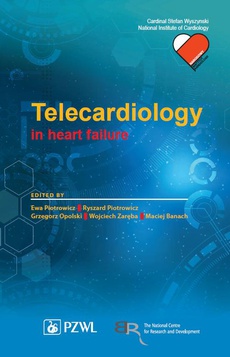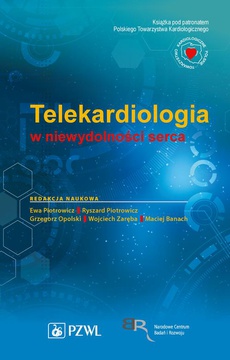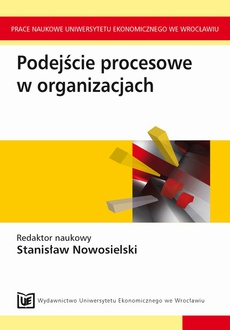INNE EBOOKI AUTORA
Telecardiology in heart failure
Wydawca:
Format:
ibuk
„Ex oriente lux”
Congratulations to the authors of this first textbook focusing on the new,
emerging field of telecardiology.
This textbook is a very important step to spread more knowledge to
clinical cardiologists – from the basics to practical issues of this new facet
of digital cardiology.
For me it is not a surprise that this important textbook was written and
published in Poland first.
Pioneer work in the field, e.g. the TELEREH-HF trial, was performed in a nationwide network of
telemedical centers.
Moreover, the Polish colleagues are working hard and with open mind.
So, there is a constant exchange of new ideas even from abroad and the cooperation with international
experts, which represents another success factor for the telecardiology in Poland.
Finally, the translation of this textbook into English is a consistent next step taken to extend
its audience for the benefit of our patients.
Friedrich Köhler
Berlin, Charite. 2020-05-06
Heart failure remains a significant challenge for health care systems
worldwide. As the medical world strives to reduce the incidence of this
disease and provide patients with more comprehensive care, the telemanagement
of heart failure patients offers a promising solution.
This book presents the role of different forms of e-Health – including
e-education and self-monitoring, internet/mobile applications, structured
telephone support, telemonitoring, telerehabilitation, remote monitoring
of cardiovascular implantable electronic devices, and haemodynamic implantable
electronic devices – in providing optimal longterm management
of heart failure patients.
Introducing telecardiology to everyday clinical practice requires educating both patients and
medical teams (physicians, nurses, physiotherapists, psychologists). In this respect, it is a unique
book devoted to the use of remote monitoring in the comprehensive care of heart failure
patients. The role of telemedicine in the management of chronic diseases is supported by
European, American, and international scienti c societies.
I would like to congratulate the authors of this magnificent book, which will be extremely useful
to fellow cardiologists as well as our cardiac patients.
Alexandru Mischie MD, PhD, FESC, FAHA / Cardiologist
Head of Interv. Cardiology Department Centre Hospitalier Montlucon, France
Chair of the Tele-Cardiology WG International Society for Telemedicine & e-Health
Board Member&Communication CNCH
Past-Secretary of the ESC-ACVC
| Rok wydania | 2021 |
|---|---|
| Liczba stron | 152 |
| Kategoria | Publikacje darmowe |
| Wydawca | PZWL Wydawnictwo Lekarskie |
| ISBN-13 | 978-83-200-6416-2 |
| Numer wydania | 1 |
| Informacja o sprzedawcy | ePWN sp. z o.o. |
POLECAMY
Ciekawe propozycje
Spis treści
| Introduction to telecardiology 1 | |
| Heart failure – a 21st century epidemic | 7 |
| Definition of eHealth and the telemonitoring process 11 | |
| 3.1. Introduction | 11 |
| 3.2. eHealth and telemedicine – defi nitions | 11 |
| 3.3. Types of telemedicine services | 14 |
| 3.4. eHealth in heart failure | 16 |
| 3.5. Polish experience gained from the TELEREH-HF project | 17 |
| 3.6. Summary | 18 |
| E-education and self-monitoring | 19 |
| 4.1. Mobile applications | 19 |
| 4.2. Websites | 22 |
| 4.3. Summary | 26 |
| Telephone support and telemonitoring of patients with heart failure | 29 |
| 5.1. Introduction | 29 |
| 5.2. Telephone support and telemonitoring in heart failure | 29 |
| 5.3. “Doc-to-Doc” telecardiology | 30 |
| 5.4. “Doc-to-Patient” telecardiology | 30 |
| 5.5. Practical implementation | 31 |
| 5.6. Data from published studies | 32 |
| 5.7. The TELEREH-HF randomized clinical trial | 36 |
| 5.8. Summary | 36 |
| Non-invasive methods of haemodynamic monitoring 41 | |
| 6.1. Introduction | 41 |
| 6.2. Impedance cardiography | 41 |
| 6.3. Lung impedance | 43 |
| 6.4. Electromagnetic technologies | 45 |
| 6.5. Spectroscopy, electrical bioimpedance | 48 |
| 6.6. Summary | 49 |
| Remote monitoring of therapeutic implantable devices | 53 |
| 7.1. Defi nition | 53 |
| 7.2. Description of the method | 53 |
| 7.3. Recommendations | 54 |
| 7.4. Evaluated parameters | 54 |
| 7.5. A review of clinical trials of telemonitoring | 58 |
| 7.6. Development of telemonitoring in Poland | 63 |
| 7.7. Innovations in telemonitoring of cardiac implantable devices | 63 |
| 7.8. Summary | 64 |
| Remote monitoring of implantable haemodynamic devices | 67 |
| 8.1. Introduction | 67 |
| 8.2. Monitoring of right ventricular systolic pressure and pulmonary arterial diastolic pressure | 68 |
| 8.3. Pulmonary artery pressure monitoring | 70 |
| 8.4. Left atrial pressure monitoring | 72 |
| 8.5. Left ventricular assist devices and biventricular assist devices | 74 |
| 8.6. Summary | 76 |
| Hybrid cardiac telerehabilitation | 79 |
| 9.1. Introduction | 79 |
| 9.2. Remote exercise monitoring | 80 |
| 9.3. Effectiveness of cardiac telerehabilitation | 82 |
| 9.4. Hybrid cardiac telerehabilitation — technology and organisation | 84 |
| 9.5. Benefi ts and limitations of hybrid cardiac telerehabilitation | 87 |
| 9.6. Hybrid cardiac telerehabilitation within the TELEREH-HF project | 88 |
| 9.7. Summary | 88 |
| Remote psychological support for patients with heart failure 91 | |
| 10.1. Main psychological problems and quality of life in people with heart failure – key definitions | 91 |
| 10.2. Psychological interventions in the treatment of heart failure | 93 |
| 10.3. Psychological assistance with modern forms of communication | 94 |
| 10.4. The influence of telecare on the psychological functioning of patients with heart failure | 97 |
| 10.5. Psychological support from other medical staff members | 100 |
| 10.6. Summary | 103 |
| New possibilities for monitoring of patients with heart failure | 107 |
| 11.1. Remote monitoring of pharmacotherapy | 107 |
| 11.2. Varia | 111 |
| 11.3. Summary | 118 |
| Benefits and limitations of telemedicine in patients with heart failure | 121 |
| 12.1. Introduction | 121 |
| 12.2. Benefi ts and limitations | 121 |
| 12.3. Digitisation of health protection and organisation | 124 |
| 12.4. Summary | 126 |
| Postscript, i.e. telemedicine in comprehensive, coordinated care for patients with heart failure in Poland | 129 |
| Index | 139 |


























